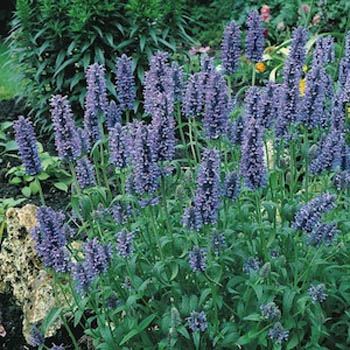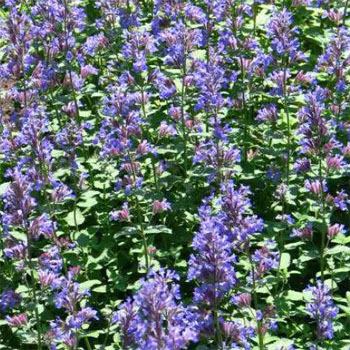New Account | Seed Mix |
Gift Certificates |AAS Winners |
Gardening Products
SEEDS: Unusual | Annuals | Perennials | Vegetables | Herbs | Trees
Catnip Seeds
Useful gardening information
Start Catnip seeds indoors near a sunny window 6 weeks before transplanting to the garden after danger of last frost. Or, if your area has a longer growing season, sow the Catnip herb seeds directly in the garden in full sun when frost danger is over and ground is warm. Make shallow furrows and cover the herb seeds 1/8 inch with loose soil. Thin or transplant the Catnip seedlings to 12 inches apart when they are 2 inches tall. Keep plants full by pinching the growing stems and flower buds when they appear. Harvest leaves by cutting the stems anytime during the growing season. The foliage keeps its scent best when air dried.
How to make you own Catnip Toy for cats

HR123 Catnip ( Nepeta cataria )
A very easy to grow plant for pots, baskets and gardens.
Catnip is a perennial herb from the mint family. It has a square, hairy stalk with typically gray green colored heart shaped leaves that have scalloped edges. Flowers grow in spikes, reaching 1/2 inch in length.
It is best known for its ability to get cats high.
Native to Europe and Asia, catnip became naturalised in North America and Canada after being introduced by the colonists in the 1600s. The name Nepeta is believed to have come from the town of Nepete in Italy, and Cataria is thought to have come from the Latin word for cat.
The active ingredient that causes a high in cats is an essential oil called nepetalactone, which can be found in the leaves and stems of the plant.
Because cats affected by catnip roll on the floor, which mimics a female in estrus, it has been suggested that the plant acts as an aphrodisiac, but this is unlikely, as males react the same way as females. What is probable is the cat is reacting to similar feel good pheromones released during sexual courtship/activity. However, non sexual behaviour including playing, chasing, and hunting can also be observed.
Around 50 to 66% of cats are affected by catnip, and to differing degrees. Kittens younger than eight weeks old aren't able to enjoy its effect; in fact, they show an aversion to it. The response to catnip is mediated through the olfactory system. When nepetalactone enters the cat's nasal passages, it binds to olfactory receptors located at the olfactory epithelium. This stimulates sensory neurons, which trigger neurons in the olfactory bulb to send signals to the brain. The response to catnip is inherited as an autosomal dominant gene, which means the gene only needs to be passed on from one parent.
It's not just domesticated cats who enjoy the effects of catnip; many other wild species of cats also enjoy it. Cats can smell 1 part per billion in the air. Males and females, fertile or desexed there appears to be no one group more readily affected by catnip than another.
A typical response includes sniffing, chewing, licking, head shaking, and chin, cheek, and body rubbing (in that order). Additional responses may include stretching, drooling, jumping, licking, aggression, and hyperactivity. Sniffing that produces the high; it is believed that cats eat catnip to bruise the catnip, thereby releasing more of the nepetalactone. The high produced will usually last between five and ten minutes, followed by a one hour refractory period.
Interestingly, researchers say that nepetalactone is about ten times more effective at repelling mosquitoes than DEET, which is the active ingredient in most insect repellents. It was also discovered that catnip repels cockroaches! Plants aren't alone in containing nepetalactone; some insects and ants also contain it. It's been speculated that this protects them from other insects.
Rats and mice are also believed to have a strong dislike of catnip and will avoid places where it grows.
Is catnip harmful to cats? Catnip is not harmful to your cat. They won't overdose on it. Most cats know when they've had enough and will refuse any further offers.
A perennial best suited for zones 4-9.
Catnip is a perennial herb from the mint family. It has a square, hairy stalk with typically gray green colored heart shaped leaves that have scalloped edges. Flowers grow in spikes, reaching 1/2 inch in length.
It is best known for its ability to get cats high.
Native to Europe and Asia, catnip became naturalised in North America and Canada after being introduced by the colonists in the 1600s. The name Nepeta is believed to have come from the town of Nepete in Italy, and Cataria is thought to have come from the Latin word for cat.
The active ingredient that causes a high in cats is an essential oil called nepetalactone, which can be found in the leaves and stems of the plant.
Because cats affected by catnip roll on the floor, which mimics a female in estrus, it has been suggested that the plant acts as an aphrodisiac, but this is unlikely, as males react the same way as females. What is probable is the cat is reacting to similar feel good pheromones released during sexual courtship/activity. However, non sexual behaviour including playing, chasing, and hunting can also be observed.
Around 50 to 66% of cats are affected by catnip, and to differing degrees. Kittens younger than eight weeks old aren't able to enjoy its effect; in fact, they show an aversion to it. The response to catnip is mediated through the olfactory system. When nepetalactone enters the cat's nasal passages, it binds to olfactory receptors located at the olfactory epithelium. This stimulates sensory neurons, which trigger neurons in the olfactory bulb to send signals to the brain. The response to catnip is inherited as an autosomal dominant gene, which means the gene only needs to be passed on from one parent.
It's not just domesticated cats who enjoy the effects of catnip; many other wild species of cats also enjoy it. Cats can smell 1 part per billion in the air. Males and females, fertile or desexed there appears to be no one group more readily affected by catnip than another.
A typical response includes sniffing, chewing, licking, head shaking, and chin, cheek, and body rubbing (in that order). Additional responses may include stretching, drooling, jumping, licking, aggression, and hyperactivity. Sniffing that produces the high; it is believed that cats eat catnip to bruise the catnip, thereby releasing more of the nepetalactone. The high produced will usually last between five and ten minutes, followed by a one hour refractory period.
Interestingly, researchers say that nepetalactone is about ten times more effective at repelling mosquitoes than DEET, which is the active ingredient in most insect repellents. It was also discovered that catnip repels cockroaches! Plants aren't alone in containing nepetalactone; some insects and ants also contain it. It's been speculated that this protects them from other insects.
Rats and mice are also believed to have a strong dislike of catnip and will avoid places where it grows.
Is catnip harmful to cats? Catnip is not harmful to your cat. They won't overdose on it. Most cats know when they've had enough and will refuse any further offers.
A perennial best suited for zones 4-9.

3481 Lemon Catnip ( Nepeta cataria citriodora )
Lemon Catnip is a subspecies of the common catnip, the attraction to cats is the same. The difference lies, not only in the lemon scent but also the appearance. The plants are a bit smaller than common catnip and the foliage is a soft green rather than gray green. Tastes great in teas and has the same mild sedative effect. Blue blooms in summer attract honeybees.
Growing Lemon Catnip is a wonderful way to bring a lemony scent to your landscape or garden, and it's a reliable plant giving years of pleasure. Start these flower seeds indoors in late winter for transplanting out after frosts have passed.
A perennial best suited for zones 4-9.
Growing Lemon Catnip is a wonderful way to bring a lemony scent to your landscape or garden, and it's a reliable plant giving years of pleasure. Start these flower seeds indoors in late winter for transplanting out after frosts have passed.
A perennial best suited for zones 4-9.
Share a growing tip or recipe and help other gardeners!
Click on the Contact Form link, place "Tip" in the name line and fill in your information. If we accept your Catnip growing tip or recipe, we will post it on this page.
